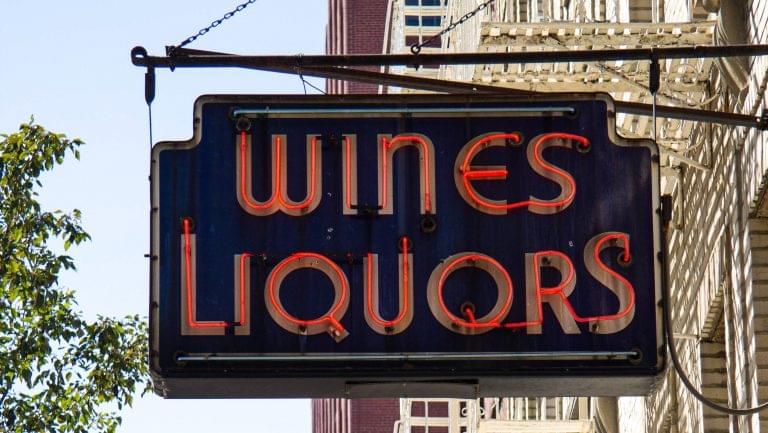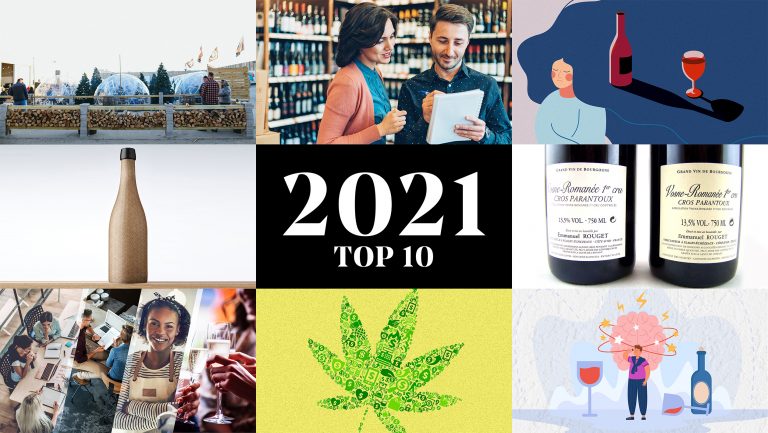The industry’s one bright spot during the devastating coronavirus pandemic has been recent weeks’ surges in wine, beer, and spirits off-premise sales across the country. With the on-premise sector shuttered and Americans confined to their homes, consumers were very much drinking, and for many alcohol retailers (which are deemed essential businesses in most states), sales surged as consumers stocked up on alcohol, alongside toilet paper and household disinfectants.
According to Nielsen, U.S. sales of alcoholic beverages increased 55 percent in the week ending March 21—the same week that California became the first of many to enact a statewide order for residents to stay at home. The four Gary’s Wine & Marketplace stores in New Jersey saw a 62 percent increase in overall sales as of March 15—before local bars and restaurants were mandated to close in that state. While retailers prepared for the initial panic-buying boom to slow, many report that sales have remained strong.
The alcohol delivery service Drizly, which is releasing sales data on a dashboard updated twice weekly, saw sales growth slow slightly before spiking once again to 488 percent over baseline during the week of March 30. Large grocery chains, in markets where they are permitted to sell alcohol, are posting very high double-digit growth in beverage alcohol.

Don’t miss the latest drinks industry news and insights. Sign up for our award-winning newsletters and get insider intel, resources, and trends delivered to your inbox every week.
For independent wine retailers, the impact on sales has been variable. Some, like Le Du’s Wines in New York City and Schneider’s of Capitol Hill in Washington, D.C., have seen sales normalize after an initial spike in purchasing. For others, like The Wine House in Los Angeles, they continue to soar. “Sales continue to increase,” says part-owner and wine buyer Jim Knight. “We have not seen a dip in consumer purchasing, and we are very fortunate for that.”
But many experts and retailers predict this will taper off and are practicing caution. “Every indication is that the initial stocking up will end at some point,” says Tom Wark, the executive director of the National Association of Wine Retailers (NAWR), “and the impact of the U.S. entering a ‘depression economy’ for some time will hit sales very hard.”
This uncertainty, combined with the rapidly changing realities of daily life in the U.S., the precarious economic climate, and new health regulations and concerns, means that it’s far from business as usual.
Understanding New Purchasing Behavior
The retail sector is the undeniable beneficiary of the on-premise fall-out. “It’s a great time to shop at a wine shop,” says Talitha Whidbee, the owner of Vine Wine in Brooklyn, New York. “We’re picking up all the allocations from restaurants.” Faced with the loss of purchases from on-premise accounts, many importers and distributors are slashing prices dramatically to offload inventory, allowing retailers to offer excellent value on wines as well. JT Robertson, the general manager of Le Du’s Wines, also says that importers and distributors are offering him unusually high quantities of highly-allocated wines because on-premise accounts cannot take them.
While some retailers initially saw consumers splurge on more expensive bottles, for the most part, the average per-bottle price point is skewing lower than usual. “The average wine bottle price since the uptick has been $17.99,” says Gary Fisch, the founder and CEO of Gary’s Wine & Marketplace, “which is roughly 32 percent lower than the average bottle price in the past year, which is $25.” The Wine House’s average bottle price has been about $20, according to Knight, which is also slightly lower than normal.
That lower per-bottle average is typically offset by greater quantity, however. “Across the board, everyone seems to be purchasing at the bottom end of where they normally would purchase, but then they buy [those] wines in [larger] volume,” says Michael Descamps, the wine director at the Red Wagon Wine Shoppe in Rochester Hills, Michigan, adding that those who initially stocked up are now returning for more as shelter-in-place projections are extended. Whidbee reports that Vine Wine’s packages of six or 12 bottles have been popular, particularly the $60, $120, and $170 six-packs, and Drizly reports that quantity per order is up as well—about 40 to 50 percent more than usual.
However, the drop in average price point has been difficult for some retailers. “Many [independent, fine wine] stores are reporting lower sales,” says Wark, “in large part because the vast majority of retailers are also seeing their average price per bottle sold significantly reduced since March 1.” He adds that between 30 and 40 percent of fine wine retailers have laid off or furloughed employees.
Managing New Protocol
As Americans comply with stay-at-home orders, retail operations that once relied on foot traffic have had to adjust to decreased or nonexistent walk-in business. To adapt, Wark notes that many retailers are increasing delivery efforts, adding curbside pick-up options, and widening digital outreach. Though 40 percent of The Wine House’s initial sales bump was walk-ins, once the state put a stay-at-home order in place on March 19, Knight was “slammed” with curbside pick-up and delivery orders.
“We have had some of the biggest web and call-in volumes ever,” says Robertson. This has required longer hours from staff members, who are working on a staggered staffing schedule with fewer physically in the shop at a given time. Robertson reports faster pick-up and drop-off times, which he believes may be due to fewer people on the streets.
The situation varies widely by state. While Pennsylvania has closed all Pennsylvania Liquor Control Board stores, in New York and California the government has deemed liquor stores “essential businesses” which means retailers do not need to reduce their workforce and may remain open for business.
However, many stores have opted to cease walk-in business over coronavirus health concerns. “We found people were bored and browsing,” says Robertson, who stopped allowing walk-in customers on March 23. “Normally that would be great, but I have to weigh what would normally be a positive for my business against the health of my staff and customers.”
The team at Schneider’s, which has lowered the free delivery minimum, launched curbside pickup, and streamlined the ordering process on their website, Cellar.com, is taking precautions when it comes to walk-in traffic. “We are open for walk-up orders at our historic storefront,” says vice president Elyse Genderson, “but not permitting customers inside the shop at this time.” Instead, staff members help customers find what they are looking for (while standing at a safe distance) and bring it outside for them.
But for shops that do not offer delivery, walk-in traffic remains crucial even under stay-at-home orders. Business at the Red Wagon Wine Shoppe in Rochester Hills, Michigan, isn’t as high as it was before the state’s shelter-in-place mandate was announced on March 23, but after an initial leveling out, it increased again during the last weekend in March. Wine director Michael Descamps still sees a lot of customers shopping in-store—something that would normally be welcome, but is now a health risk. “Many are purchasing as if there is no crisis or disruption to their lives, buying one bottle of wine or a six-pack of beer,” he says.
Restrictions on delivery in Michigan, also a control state, make it complicated and expensive to deliver; all carriers of alcohol must have certifications from the state, requiring permits and fees that many small stores choose not to take on. This is why Red Wagon does not offer delivery, though it does have an e-commerce site offering shipping. “Our model, which is so heavily dependent on in-store traffic, would just about come to a halt,” says Descamps. “Honestly, I do not know if we will opt to stop walk-in traffic. I am hoping that we do as the risk is mounting every day just to be open for the public.”
To mitigate the risk, Descamps has reduced hours and is working with a very small team (many staff members have opted not to work due to coronavirus health concerns). Other protocols enacted by wine shops that continue to offer walk-in business include canceling in-store tastings, staggering staffing, limiting the number of shoppers allowed at once, sanitizing surfaces regularly, and requiring employees to wash hands and wear gloves.
Investing in the Delivery Model and E-Commerce
Even if shelter-in-place orders allow consumers to shop in-store, many are opting for web or phone sales to minimize contact with others. According to Nielsen, online sales of alcoholic beverages rose by 243 percent during the week ending March 21. It’s been a boon for alcohol delivery services like Drizly and Minibar and large online marketplaces. During the week ending March 29, wine app Vivino experienced a 209 percent increase in year-over-year gross merchandise value for their online marketplace business—much of that from new customers.
“People who previously used Vivino for scanning, rating, and reviewing wines are now buying online because they are at home, online, and looking for delivery to their door,” says founder Heini Zachariassen. “Our numbers indicate that [e-commerce and delivery are] essential.”
Independent retailers are seeing results from this shift, too .“Almost all our members report moderate to significant increase in traffic to their websites,” says NAWR’s Wark. For businesses that have delivery or shipping systems in place, this shift away from walk-in traffic is smoother. “Our retail world has been shifting to shopping online in general, so we have been prepared for this,” says Knight.
Robertson estimates that 70 to 80 percent of business at Le Du’s is based on direct client sales through private client sales relationships; using FedEx, couriers, and in-house delivery services, they are offering free delivery in the New York tri-state area until shelter-in-place orders are lifted.
Though consumers seem to be avoiding walk-in traffic, some retailers are reporting that orders for pick-up remain strong. Vine Wine’s Whidbee estimates that 90 percent of the shop’s orders are for pick-up, despite the fact that local delivery and New York state shipping are free. “We have a lot of neighborhood business,” she says. “People still want to go out and take a stroll since they’re inside all day.”
Particularly for small shops, delivery may indeed be the only way to remain operational and profitable. “I strongly recommend that small mom-and-pop stores invest heavily in their delivery and pick-up capabilities,” says Fisch. He suggests retailers look into all e-commerce options, such as hiring a third-party delivery service or back-end technology provider. Whidbee also recommends having all inventory online and linked to the store’s POS system to reflect real-time availability.
For retailers without e-commerce sites, don’t just partner with one third-party application—partner with them all. “It’s critical to offer your store on as many third-party applications as possible,” says Brian Rosen, the president and founder of BevStrat, likening it to restaurants who offer delivery through multiple platforms. “The more you can be shopped, the more you can be bought.” And if a shop is restricted to phone sales only, according to Rosen, ensure that team members have a list of wines that have high margins and are easy for the consumer to understand.
Managing pick-up and delivery operations and coronavirus health protocols is also essential. To keep business manageable with just a few staff members, Vine Wine conducts local delivery on Mondays, ships packages on Tuesdays and Wednesdays, and offers pick-up for four hours each day from Tuesday to Saturday. For the safety of both customers and staff, zero-contact pick-up and delivery protocols are also increasingly important. Some retailers place a card table outside the front door of the shop so that consumers cannot get too close, or staff members wear gloves to place orders in car trunks. For delivery, the team at The Wine House asks the customer to show his or her ID through the window and leaves the order on their doorstep.
It’s critical for retailers to communicate directly with customers through social media and emails about their delivery services—particularly for shops without robust ecommerce platforms. Justin Hill, a principal at architecture and retail strategy firm MG2, encourages retailers to send personal emails to customers in addition to bigger mailing list blasts. “Depending on the size of the retailer,” he says, “a personal note checking in on people with a possible suggested bottle of their favorite varietal [wine] would be great for many.”
“There’s a lot of uncertainty as to whether shops are even open, so just sending out an email or posting that you’re open is very advantageous,” says Robertson. “More often than not, people will choose to support their small businesses.” He has also been using sponsored Instagram and Facebook posts highlighting the shop’s delivery radius to target the local community, noting that even if couriers are no longer allowed to operate, he can personally deliver bottles a few blocks away.
Planning for an Unpredictable Future
Several wine and spirits distributors who spoke with SevenFifty Daily report that they predict the boom will continue to slow for independent retailers, particularly in states where grocery stores are permitted to sell alcohol and consumers increasingly opt for one-stop shopping. “I anticipate that with the stay home order, we will continue to see some slowdown,” agrees Genderson. Still, the future is uncertain; as some shops experience a return to normal, others report record sales numbers, and still others continue to lag in sales.
Seeing the drastic and swift effects that the coronavirus crisis has had on the on-premise segment of the wine industry also has Robertson preparing for the worst. “I’m trying to get to a point where everything I’m selling is to cover my payroll and keep the lights on for the next four to six weeks,” he says. “We’re very much operating day to day.”
Some are anticipating unexpected disruptions in other parts of the industry, such as the winery supply chain. “I still feel like we have to overbuy,” says Whidbee. “I’m worried that there’s going to be a travel ban or they’ll close down the ports for two weeks.”
Flexibility will be key to both short- and long-term success. “I think we’re looking at a drastically different wine landscape in the future,” says Robertson.
Editor’s note: This article was updated on April 8, 2020 to reflect updated sales numbers and include additional sources.

Dispatch
Sign up for our award-winning newsletter
Don’t miss the latest drinks industry news and insights—delivered to your inbox every week.
Courtney Schiessl Magrini is the editor-in-chief for SevenFifty Daily and the Beverage Media Group publications. Based in Brooklyn, she has held sommelier positions at some of New York’s top restaurants, including Marta, Dirty French, and Terroir, and her work has appeared in Wine Enthusiast, GuildSomm, Forbes.com, VinePair, EatingWell Magazine, and more. She holds the WSET Diploma in Wines. Follow her on Instagram at @takeittocourt.







